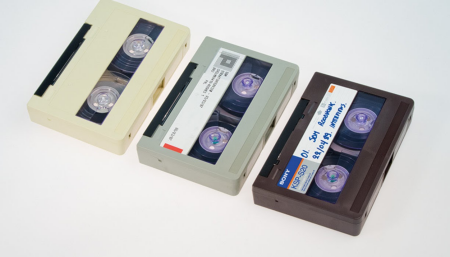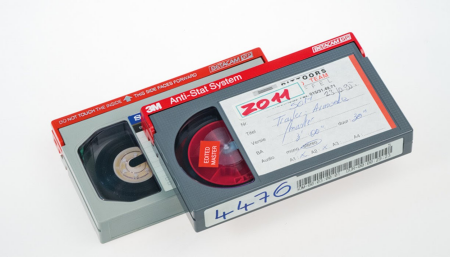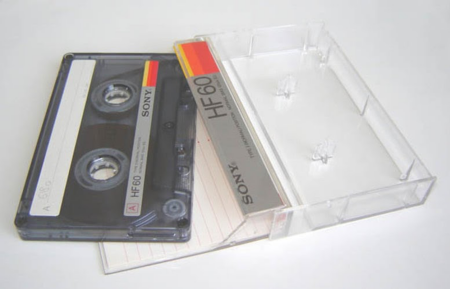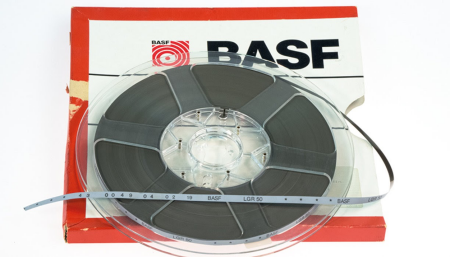Digitisation project 1: U-Matic, Betacam SP, audio cassette and 1/4-inch audio tape
For our first digitisation project, we selected four very common, endangered carriers of audiovisual material, in cooperation with PACKED VZW. The digitisation is in the hands of Memnon Archiving Services and Sonim Production.

Through a first European tendering process in October 2013, the digitisation of the video formats was awarded to Memnon Archiving Services and the audio formats to Sonim Production. An extra batch of audiocassettes was awarded to Gecko in 2018.
The carriers within this first digitisation project:
U-Matic
Between October 2014 and June 2016, we digitised 12,640 carriers from 33 cultural heritage institutions and one broadcaster. In 2018-2019, a second round followed for another 1,500 cassettes.

U-Matic was the first video cassette format to break through in professional media. In the 1980s, the cassettes formed a flexible alternative to video tapes on open reels and even film on celluloid. In the early 2000s, when the Flemish television channel VRT decided that U-Matic cassettes were quickly becoming outdated and that the associated playback machines were reaching the end of their lifespans, we began to digitise them. AVS was the only regional broadcaster that had worked with U-Matic but, in the cultural heritage sector, there were thousands of cassettes ready to be digitised. All these U-matics were digitised by Memnon, who we also counted on for the digitisation of Betacam SP, Digital Betacam and Betacam SX.
To the final report on the digitisation of U-Matic cassettes (only in Dutch) >
Betacam SP
Between January 2014 and February 2017, we digitised 42,600 carriers from 28 cultural heritage institutions and eight broadcasters. In 2019-2020 we digitised approximately 15.000 Betacam SP tapes from MEDIALAAN (nu DPG Media). A good 200 carriers from five other content partners came joining them.

In the 1990s, Betacam SP was the professional standard in the field of television production and was even used into the 2000s by some organisations. Public and regional broadcasters have the largest number of Betacam SP cassettes, full of television programmes or broadcasts by third parties, while cultural heritage organisations have a smaller collection. Only ten years after introduction, the first wear was seen in the form of stickiness due to fluctuations in temperature and humidity. In May 2015, Sony stopped the production of video players, including the Betacam SP player. The playback equipment for Betacam SP cassettes is disappearing slowly but surely. With this and the vulnerability of the carriers in mind, we have prioritised the digitisation of the Betacam SP carrier. This project had been awarded to Memnon for a second time, after they also digitised U-Matic, Digital Betacam and Betacam SX.
Audio cassettes
Between January 2014 and the summer of 2017, we digitised 15,5500 carriers from 18 cultural heritage institutions and one broadcaster. In 2018-2019 we digitised an extra amount of about 6,700 audio cassettes.

Audio cassettes were not used by professionals, but they are exposed to the same risks as Betacam and U-Matic cassettes: they easily become sticky, causing them to get stuck in the video player. Remnants of metal particles are often left behind on the read heads, which wipes the content, or the tape unravels and gets stuck in the player. VIAA’s digitised audio cassettes contain a wide range of recordings: interviews, music recordings and radio programmes form a fascinating addition to the VRT radio archive. After the first digitisation of this popular format, our content partners kept reporting additional amounts of, even after our existing contract with digitisation partner Sonim Production approached its end date. That is why we wrote a new tender in 2018, which was won by the French company Gecko. They digitised this extra batch of about 6.700 cassettes in 2019.
To the final report on the digitisation of audio cassettes (only in Dutch) >
1/4-inch cassettes
Between January 2014 and June 2019, we digitised approximately 101,300 carriers from 53 cultural heritage institutions and one broadcaster.

Quarter-inch cassettes were popular among professionals, amateurs and private individuals. Meemoo has digitised more of these than of any other carrier type. In the mid-1970s, audio cassettes conquered the living rooms but the 1/4-inch cassette remained the standard within radio until the late 1990s. One of the reasons why we have included the digitisation of these carriers in our first digitisation project is the large volume, but the stickiness and flaking also played a role. The aging of the playback equipment is not critical, but replacement parts are becoming rare. The digitisation is being handled by digitisation company Sonim Production who also digitised audio cassettes and the first batch of VCR for us.
